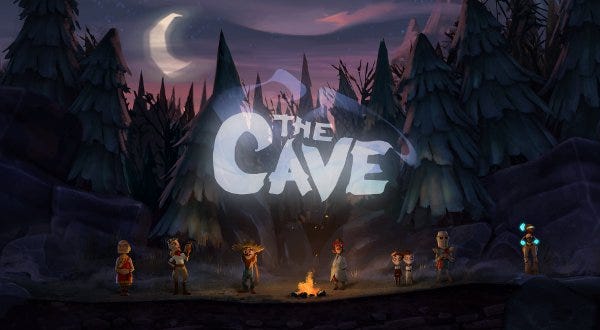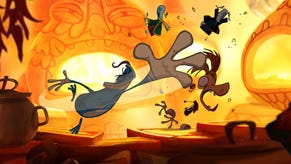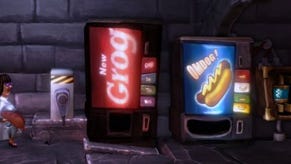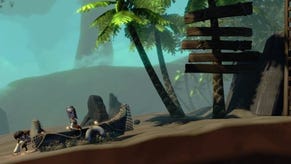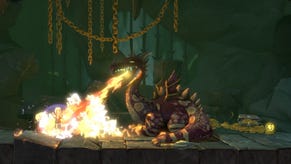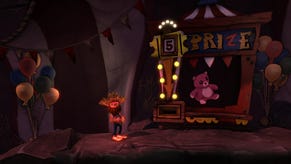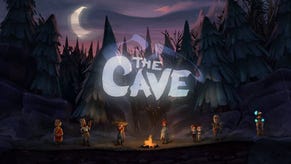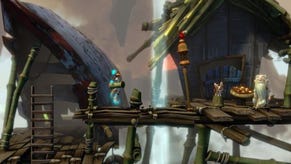Ron Gilbert On Being A PC Gamer, What's Next
Looking Back, Moving Forward
The Cave is right around the corner. Well, not literally - unless you live inside a rocky outcropping in the frigid wildness or are being stalked by some kind of sentient, not-completely-immobile cave. But Ron Gilbert's Cave is rapidly nearing its January 2013 release date, and naturally, that raises questions. Fortunately, I was standing right next to the very same Ron Gilbert when those questions came up, so I decided to ask him. Find out after the break why - in spite of its platform-y looks - The Cave's a PC game at heart and how that ties into Gilbert's plans for whatever he ends up making next.
"I'm primarily a PC gamer," Gilbert replied when I asked him about The Cave's PC functionality. "I boot up my Xbox once a month. Mostly I play PC games."
"To me, making sure that PC game felt really good and natural to play with the mouse - and not just, like, a bad console port to PC - was personally very, very important. So yeah, I want to do as much as humanly possible with the mouse and all that. On the PC version, you'll just be able to click with your mouse. Characters will walk to wherever you click. Switching characters with the keyboard by just hitting the number keys [is also an option]. So there's some streamlining like that that happens with the PC version."
Which is tremendously good news, because slippery, over-sensitive movement controls were one of the biggest downsides of the (sadly console-only) build I got to go hands-on with. That said, even though I'm not a fan of the near-final version's execution on that front, I can't entirely fault Gilbert's rationale for giving his old-school adventure sensibilities a modern platformer facelift. Because that's exactly what it is: a facelift. In truth, the similarities are only skin-deep.
"I don't particularly enjoy platformers," he admitted. "I'm not a platformer player. I get really frustrated when I'm missing jumps and I just want to go somewhere. I know what I want to do, [but I can't do it]. Adding that thin layer of platforming was about making that movement more fun. Giving the players something to do while they're thinking around things and solving puzzles. They can still be jumping around the screen or swinging from ropes. But I didn't want it to become this full-blown puzzle platformer. I didn't want that to distract from it being an adventure game and what adventure games are all about."
"Part of it was just kind of looking at where people are playing games. Consoles are still really popular, so part of it was just kind of being able to address that. I don't play a lot of console games, but I do find them very fascinating in a way. There's more of a direct connection between the character and the player, because you've got that controller. That stuff's always been interesting to me, and I wanted to kind of play with that."
Gilbert's heart, though, remains in our hallowed hardware forest of towering cases, motherboards, and supercooled graphics cards, and developing one game with consoles at the forefront certainly hasn't caused him to lose sight of that.
“Yeah, absolutely," he replied when I asked if his next project will be more PC-centric. "Absolutely.”
"I definitely am [happy to see PC back in the limelight]," he added. "It's where I play a lot of my games. And, you know, console games are kind of in a downfall because we don't have anything new from the major hardware manufacturers... well, OK, maybe Nintendo. But not Sony or Microsoft yet."
The tricky part, though, is figuring out what exactly that next something will be. And unfortunately, adventure game design isn't like playing an adventure game. You can't just haphazardly throw items together until something suddenly (and, let's face it, oftentimes bafflingly) works. Gilbert, though, takes that measured, methodical development approach to nearly legendary levels. He's fairly notorious for obsessive tweaks and puzzle overhauls mid-development, so unsurprisingly, his new project brainstorm sessions have been known last longer than some games' entire development cycles.
"It's been, I think, 25 years since I first thought of the idea for The Cave. So that germinated for quite a while. I tend to think a lot about that stuff," he explained. "I tend to work on games, and by the time I get to the end of them, I'm so burnt out that I need, like, a month to just kind of let my mind go."
"Even Monkey Island, I thought about that game and did work on it for almost two years before it ever went into production. Just kind of mulling stuff through my head about different ideas, who Guybrush was, the pirate theme - that just sat with me. So yeah, I tend to let ideas sit with me until something just pops up or something makes it right."
Most recently, that something was a talking cave. Meaning that both the effectiveness of his method and its latest, hopefully greatest result speak for themselves. So take your time, Ron. Take your time. (But maybe not another quarter-century.)
